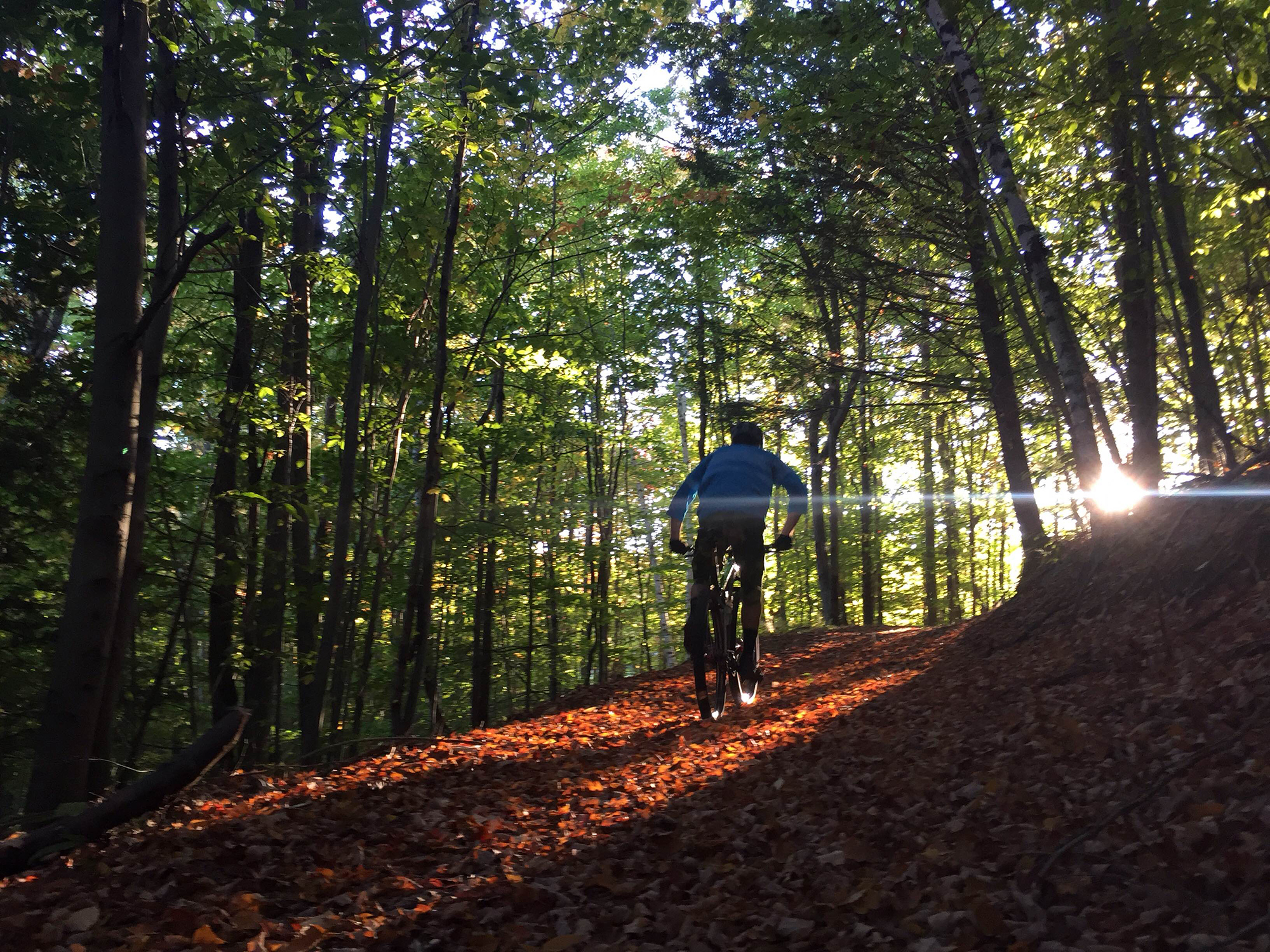Stowe Trails Partnership is excited to announce that class 1 pedal-assist electric mountain bikes (eMTB) are officially allowed in Cady Hill, Adams Camp, and Sterling Forest trail networks to make our trails more accessible for all, regardless of ability, age, or health. E-bikes are not allowed on the Billings Trail in Sterling Forest per the landowner’s request.
September 2024 Update: Trapp Family Lodge also now welcomes Class 1 Pedal-Assist E-Bikes on their network of bike trails. They love seeing the enthusiasm from the E-biking community and are glad to open their trails to those choosing an E-bike. Please note that there are trails within the Trapp network that are only for foot and ski traffic. Thank you for respecting the hard work of their trail crew and staying on the bike trails.
Ride Respectfully
We ask all trail riders to adhere to IMBA’s Responsible Riding guidelines as well as Trails for Common Ground’s eMTB resources.
- Know Before You Ride: Only ride trails that are posted as being open for E-bikes. Never ride your E-bike on a trail that doesn’t allow electric-assist bikes. Ignoring local trail use laws can give a bad name to other E-mountain bikers! Check Trailforks or Stowe Trails Partnership’s website for locations and more information.
- Stay On the Trail. Whether you are on an electric mountain bike or a regular mountain bike, always stay on the designated trail. Don’t cut corners, ride through vegetation, or create shortcuts, it could damage the trail and/or surrounding wildlife.
- Stay Off the Trail When it’s Wet. Rock, sand, clay, or loam – trail surfaces vary depending on location. If it has rained recently, it’s always best to check on current trail conditions. Riding on muddy or soft trails can cause significant trail damage. Within 24-36 hours of rain, please check our Conditions page as to whether trails are open: StoweTrails.org/Conditions
- Keep Your Speed in Check. Although going fast on your E-bike can be fun, it can also be dangerous to yourself and others. When riding near other trail users, slow down. If you must pass, be polite. Ask the other rider or hiker if you can pass and allow them to respond before maneuvering around them. Also keep in mind that the faster you go, the more difficult the trail will become. Look ahead and make sure to check your speed for upcoming trail obstacles and corners.
- Yield to Riders and Other Users. Many of Stowe’s trails are bi-directional, and it’s important that descending riders yield to climbing riders in accordance with the IMBA guidelines. Only pass when it is suitable for both riders – the best practice is for the trailing rider to wait for the leading rider to yield or reach a good stopping place. Yield for all other trail users.
What is an E-Bike?
By the existing federal definition, e-bikes are two or three-wheeled cycles with fully operable pedals and an electric motor assist of no more than 750 watts (also known as 1 horsepower). For those familiar with wattage, that figure is a bit misleading, as it is peak power output – almost all modern eMTBs have a nominal power output of 250 watts.
There are 3 primary classes of eMTBs: Class 1, Class 2, and Class 3. Class 1 e-bikes have an electric assist that ceases to provide assistance when the bicycle reaches the speed of 20 miles per hour, and the electric motor works only when the rider is pedaling (referred to as “pedal-assist”). Class 2 e-bikes are also limited to a top assisted speed of 20 miles per hour but include both pedal-assist and a throttle that can be used without pedaling. Class 3 bikes have an electric assist limited to 28 miles per hour and are also pedal-assist,
When we refer to eMTBs, we typically are talking about Class 1, pedal-assist mountain bikes, and not throttled bicycles of any kind. All eMTBs presently produced by major bicycle companies in the US are Class 1.
How Are We Handling E-Bike Concerns?
Vermont Mountain Bike Association (VMBA) acts as the umbrella organization for 29 Chapters, including Stowe Trails Partnership. We are working closely with them to learn all we can about e-bikes and how they impact the following four areas:
- Environmental. Initially, the presence of a motor on these bicycles led to concerns that eMTBs would produce more trail tread damage, as it is well-established that off-road motorcycles and ATVs remove substantially more material from trail surfaces than hiking or mountain biking (Natural Resource Impacts of Mountain Biking – American Trails). A recent study, however, showed that the tread impacts of eMTBs are essentially the same as analog bikes, and behavioral choices – e.g. riding on muddy trails – can have a much more profound impact. Nonetheless, if eMTBs enable riders to cover more distance and ride longer, the overall impact of a rider on a given day could be greater.
- Social. Class 1 eMTBs allow a rider to travel at higher speeds (limited to 20 mph) uphill, which could result in them encountering and overtaking more trail users along a given stretch of uphill or flat trail. This could lead to more disruptions and an overall less positive experience for other users – including analog mountain bikers. It is worth noting that the electric assist for Class 1 eMTBs cuts out at 20mph, these bikes do not travel significantly faster than analog bikes downhill, and the uphill speeds achieved by eMTBs are similar to those of very fit riders on analog bikes, as demonstrated in a recent environmental assessment in the Tahoe National Forest.
- Safety. The pedal assist capability of eMTBs can allow users to pedal deeper into trail systems than they would on an analog mountain bike, and travel at higher rates of speed on certain – predominately uphill – sections of trail. The related concern is that those on eMTBs could either find themselves in over their head – should a battery die, for instance, or lead to speed-related crashes over certain terrain.
- Legal. If and when trails are opened to eMTBs, their designation can change from ‘non-motorized’ to ‘motorized’, as is presently the case for trails on USFS land. This reclassification can have significant implications for funding and regulations, and affect whether specific trails are eligible for certain grant programs, trail manager liability, etc.
Learn more about e-bikes and existing policy.
Additional Resources
- Vermont S.66 (Act 40), A bill relating to electric bicycles
- Kingdom Trails Association eMTB policy
- USFS Guidance on eMTB use in National Forests
- IMBA eMTB FAQs
- BLM – e-Bikes on Public Lands
- NEMBA’s position statement on eMTBs
If you have any questions about the use of E-Bikes on the Stowe trails network, please reach out to our Executive Director at carolyn@stowetrails.org.







